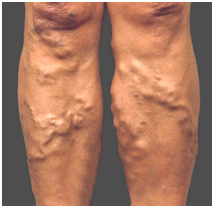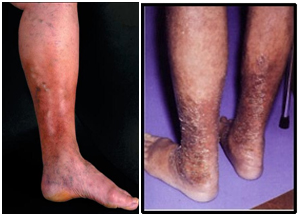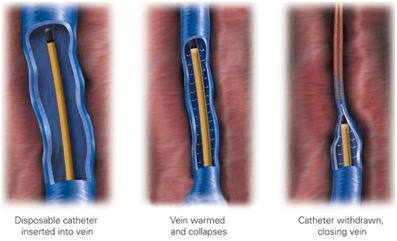Q. What are varicose veins?
 A. Varicose veins are abnormally enlarged superficial veins usually seen in the thigh and leg.
In the majority of cases, these large superficial veins are of a cosmetic nuisance. These veins connect with the deep
veins of the leg and play a minor role in the transfer of blood to the heart.
A. Varicose veins are abnormally enlarged superficial veins usually seen in the thigh and leg.
In the majority of cases, these large superficial veins are of a cosmetic nuisance. These veins connect with the deep
veins of the leg and play a minor role in the transfer of blood to the heart.
Q. What generally happens to varicose veins?
A. In the majority of cases, the varicose veins worsen with time. The varicose veins start to become
more prominent and swell. With time, the veins are engorged with blood and can cause localized pain and itching. Once the
veins become prominent, it is very unlikely that they will spontaneously resolve without any treatment.
Q. What causes varicose veins?
A. The cause of varicose veins is unknown but is definitely linked to increase pressure in the veins.
There are valves in the veins which prevent the back flow of blood back into the legs. When these valves become
amaged / defective, the blood flows backwards and causes swelling and engorgement of the veins.
Q. Who can get varicose veins?
A. Conditions that can cause destruction of the veins are pregnancy, obesity, prolonged standing and trauma.
Varicose veins are more common in females and this has been linked to the sex hormone, estrogen.
 Q. What are symptoms of varicose veins?
Q. What are symptoms of varicose veins?
A. Beside from being unattractive, varicose veins may be responsible for leg aches, a feeling of heaviness or
fatigue of the legs. The majority of individuals will complain of leg ache at the end of the day. Symptoms are often worse
after prolonged standing and may include feelings of fatigue, heaviness, aching, burning, throbbing, itching, cramping, and
restlessness of the legs.
With time, darkening or hyperpigmentation around the ankles is a classic feature of prolonged varicose veins. Varicose veins
do not cause joint pains or decrease in blood supply to the legs.
Q. How can varicose veins be diagnosed?
A. Varicose veins can usually be diagnosed by a simple physical examination. However, the cause of the
varicose vein requires the use of Doppler ultrasound. This painless test assesses the valve function in the groin and can
also determine how much blood is flowing back into the legs. The test can also determine the presence of blood clots in the
veins.
Q. What is the treatment option of varicose veins?
A. The latest treatment of varicose vein is using ultrasound Doppler with laser or radiofrequency ablation.
In both techniques, the vein is burnt away. Both procedures are relatively painless. The radiofrequency ablation better treats
saphenous incompetency, perforators and side branches of varicose vein which is not possible with laser.

The Radio-frequency Ablation has many advantages like: -
- It is less risky as compared to surgery.
- No surgical scar on skin.
- Procedure done under short/local anesthesia.
- It is done as day care or 24 hrs hospital stay.
- Patients can resume normal activities within a day.
- The recurrence rate is very low as compared to surgery.
Other treatments are
1. Conservative Treatment: - Elevating and flexing your legs can help reduce leg swelling and relieve other symptoms.2. Compression Stockings: - Compression stockings are elastic stockings that squeeze your veins and stop excess blood from flowing backward. You may be required to wear compression stockings daily for the rest of your life.
3. Sclerotherapy: - This is only for short segment disease.
Vein Stripping Surgery: - It is a major surgery. Physician disconnects and ties off all major varicose vein branches associated with the saphenous vein, he than removes the saphenous vein and varicose veins from your leg surgically. The recurrence rate is too high and it leaves ugly scars. It needs 2-3 weeks for recovery.
Q. Are varicose veins serious?
A. In the majority of cases, varicose veins are of a cosmetic nuisance. Varicose veins generally tend to get
worse without any treatment. Those who do not get them treated are more likely to develop:
- constant itching
- pigmentation around the ankles
- ulcers at the ankles
- mild to moderate swelling of the feet
- occasional blood clots in the veins
- infection of the vein
Q. Can one prevent varicose veins?
A. If one starts early, varicose veins can be prevented. The major preventive measure is to exercise and
wear compression stockings.
- Elevation of the legs at all times is also recommended.
- During pregnancy, one should always lie on the left side with the legs elevated on a pillow. This prevents the fetus from pressing on the leg veins and decreases the chance of developing varicosities.
- One should avoid standing for prolonged periods.
- Don't cross your legs when sitting down.
- Wear elastic support stockings.
Q. What problems can occur if left untreated?
A. Most people with varicose veins do not develop complications. It is impossible to predict who will develop
complications. The size of the varicose vein is not related to complications but the duration of the varicose vein is.
Complications that may occur include:
- Superficial thrombophlebitis, in this condition, the varicose vein is inflamed and tender. A clot is usually present in the vein.
- Bleeding, even with minor trauma, the varicose vein may bleed. Because the vein is under high pressure, the bleeding can be quite profuse.
- Venous Eczema, the skin around the vein may become dry and very itchy.
- Venous Pigmentation - this is brown staining of the skin around the ankle. It is due to the leakage of small amount of blood from the veins into the skin.
- Venous Ulceration - ulcers at the ankle.
Q. Is Varicose Vein treatment by Radiofrequency Ablation covered by insurance?
A. Depends on what kind of insurance policy you have. Mostly yes.